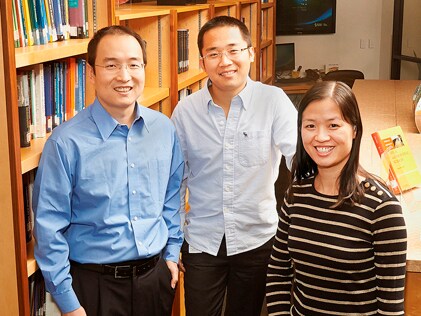Announcing Three New SAS/STAT® Procedures from Three First-Time Developers
SAS/STAT 13.1, which was recently released, includes three new SAS/STAT procedures that represent the first procedures developed by three research statisticians on the statistical R&D staff at SAS. These procedures are the BCHOICE, IRT, and ICLIFETEST procedures, which introduce Bayesian choice models, item response models, and nonparametric survival analysis of interval-censored data, respectively.
Research Statistician Developer Amy Shi, who supports the BCHOICE procedure, earned her PhD from the Department of Biostatistics at the University of North Carolina at Chapel Hill before she joined SAS. She wrote her dissertation on diagnostic measures for missing covariate data and semiparametric models under Professor Joseph Ibrahim.

Discrete choice models are used in marketing research to model decision makers' choices among alternative products and services. The collection of alternatives is known as a choice set, and when individuals are asked to choose, they usually assign a utility to each alternative. "I have a Bayesian background, but I had to learn about choice modeling and its uses in marketing," said Shi.
The BCHOICE procedure provides Bayesian discrete choice models such as the multinomial logit, multinomial logit with random effects, and nested logit. The probit response function is also available. You can supply a prior distribution for the parameters if you want something other than the default noninformative prior. Shi worked closely with Senior Manager Fang Chen, who oversees Bayesian statistical software development and supports the MCMC procedure himself. Together, Chen and Shi selected the optimal sampling algorithms for the various choice models.
"I am very interested in making contributions to the practice of statistics," said Shi. "There's been a heavy demand for Bayesian choice models, so it's really exciting to see PROC BCHOICE get into the field."
Shi will present a tutorial on her work at the Advanced Research Techniques (ART) Forum in Santa Fe, New Mexico, in June 2014.
Research Statistician Developer Xinming An, who wrote the IRT procedure, received his PhD from the Department of Psychology at UCLA under the guidance of Professor Peter M. Bentler. His research focused on the development of advanced computational and modeling techniques for latent variable models, such as item response and mixed-effects models.
"I learned R programming in school, but my research was computationally intensive, so I started to use the Fortran language," An said. "I grew to love the programming aspects of my work, and thus SAS was a great fit for me when I finished my degree."
The experimental IRT procedure fits item response models. These models are widely used in education to calibrate and evaluate items in tests, questionnaires, and other instruments; they are used to score subjects on their abilities, attitudes, and other latent traits. In recent years, item response theory has also become increasingly popular in health behavior, quality-of-life, and clinical research. PROC IRT supports several response models for binary and ordinal responses, including Rasch models; one-, two-, three-, and four-parameter models; and graded response models with a logistic or probit link.
An will give a presentation on the new IRT procedure at SAS Global Forum in Washington, DC, in March.

Changbin Guo wrote the ICLIFETEST procedure, which does nonparametric survival analysis in the presence of interval censoring. Guo received his PhD in 2011 from the Division of Biostatistics at the Medical College of Wisconsin after writing his dissertation on regression models for association in clustered survival data under Professor John Klein. Guo has a background in C programming that goes back to his undergraduate days at the Harbin Institute of Technology in China. He came to the United States to study actuarial science, but a course in mathematical statistics took him on a somewhat different career path. He was soon on his way to the PhD program in Wisconsin.
"My background in actuarial science did influence my decision to concentrate on survival analysis, and my job working on software for survival analysis puts it all together," Guo said. "I really enjoy my work at SAS, and I'm thrilled to see PROC ICLIFETEST get into the hands of customers." Guo will give a talk on the ICLIFETEST procedure at SAS Global Forum in March.
Survival analysis is a very active area of SAS/STAT software development, and other new advances in SAS/STAT 13.1 include the competing-risks model of Fine and Gray, which is provided in the PHREG procedure. Guo is now finishing up work on yet another procedure for survival analysis of interval-censored data, the ICPHREG procedure, which performs Cox regression. The ICPHREG procedure will become available in the summer of 2014 with the release of SAS/STAT 13.2.
Senior Director Bob Rodriguez, who directs statistical software development at SAS, is pleased with the new work. "We have hired a number of talented statistical developers in the last few years, and we are now seeing the fruits of their efforts," he said. "The energy we have here is terrific, and we can't wait to get even more new work out to our customers." Senior Director Maura Stokes agreed: "It's a really exciting time to be working in statistical development at SAS."